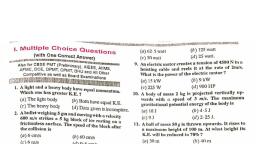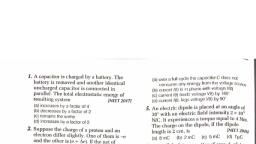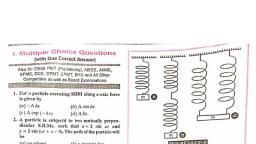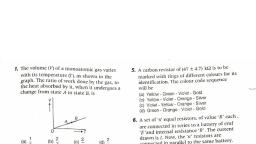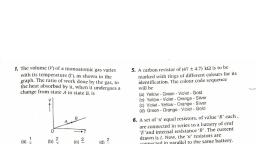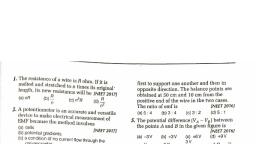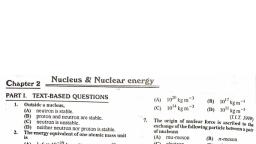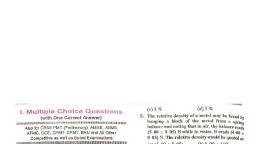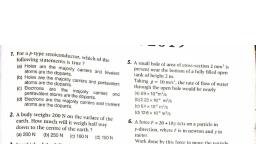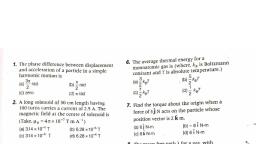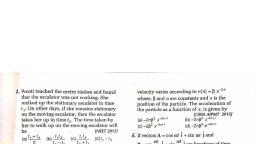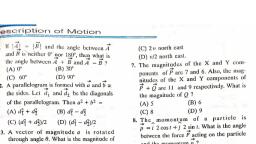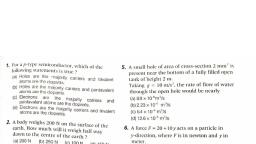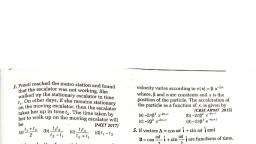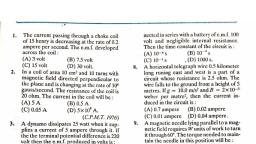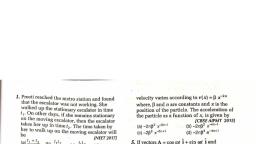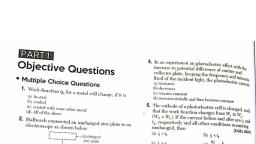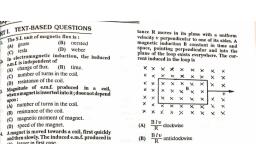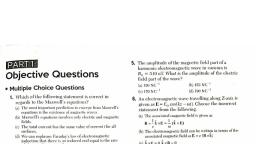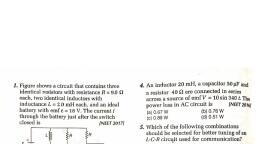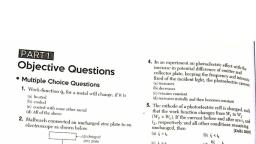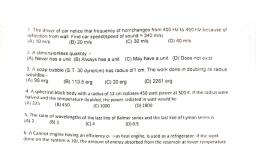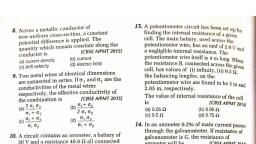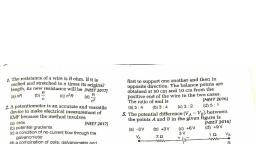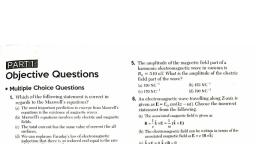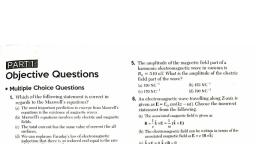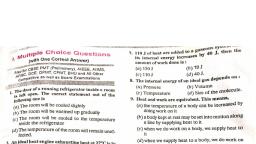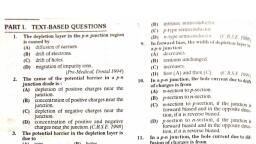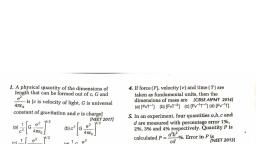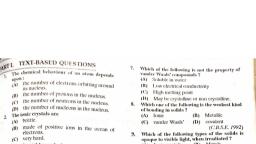Page 1 :
er, |. TEXT-BASED QUESTIONS, , S.L unit of magnetic Mux is ;, , The s (B) oersted, , (D) weber, electromagnetic induction, the induced, is independent of, change of flux. (B) time., number of turns in the coil., 0) resistance of the coil., Magnitude of emf. produced in a coil,, . Mhena magnet isinserted into it; doesnot depend, , , In, Mem, , a number of turns in the coil., (B) resistance of the coil., (C) magnetic moment of magnet., (D) speed of a es, moved towards a coil,, j ake The induced oct prelecai is, (A) larger in first case., (B) smaller in first case., (C) equal in both cases., (D) larger or smaller, depending upon resis| tance of the coil., & Refer to the figure. Deflection in the gal- vanometer (G) occurs, when :, (pre, i,, , , , , , eal OO Lah, , , , f§ N], BAR MAGNET, , , , Se ee, , coll, , (A) the magnet is pushed into the coil., (8) the magnet is rotated into the coil., , () the magnet is stationary at the centre of, py Recoil., ) the number of turns in the coil is reduced., fp (Karnataka Entrance, 1992, 1990), relay 8 law of electromagentic induction is, (A) — law of conservation of, S oa 4B) energy, hi cong Buar momentum, (CELT. 1998), , Square loop of side L and resis713, , ——, , tance R moves in its pla, , Plane with a unifi, velocity v perpendicular to one of its siden. A, magnetic induction B constant in time and, Spice, pointing perpendicular and into the, , plane of the loop exists everywhere. ‘ rent induced in the loop is ——, , , , , , , , , , uM wR & xx xX x, XX wx KR XM KY, , K KIX KK xX KIx x, , x xlx x x By x -—, x XIX xk K wx xIX x, eM oN oN ee MN, *RX XK XX KX, {A) Ba kwise, (B) BI anticlockwise, (c) 281 anticlockwise, (D) zero (LLT. 1989), , Asquare shaped coil of side 10 cm and number, of turns 500 is placed perpendicular to mags, netic flux lines, which is changing at the rate of, , 1-0 Ts), The e.m.f. induced in the coil is, , (A) 0-1V (B) O-SV, (C) 1:0V (D) 5:0V, (C.P.M.T.. 1990), , A magnetic fleld of 2 x 107? T acts at right, , angles to a coil of area 100 cm? with 50 turns., ‘The average e.m.f. induced in the coil is 0-1 V,, when it is removed from the field in the time ¢,, The value of f is, (A) O-ls, , (Cc) 1s, , (B) 0-01s, (D) 10s, , (C.B.S.E. 1992), Magnetic flux ¢ (in weber) in a closed circuit of, , resistance 10 Q varies with time f (in seconds), according to the equation :, , ¢=S0-46+1., , The magnitude of the induced e.m.f. in the, circuit até = 0-2 sis:, , (A) 0-4V, (C) -2V, , -0:4V, 2Vv, , (B), ()
Page 2 :
hy,, , ing Corer Se ERELES Linh, meetin ai =, only angular spread takes Place,, B) only angular deviation takes place,, (c)_ bothangular deviation and an, yes ie ular spread, either angular spread or angyy, ints, , for the, mean colour takes place depenaina®, tne angle of the prism. (Karnataka, 1995), Athin prism P; with angle 4° ana made from, , Jass of refractive index 1-54 ig combined with, another prism P; made from glass of refractive, index 1°72 to produce dispersion without, deviation. The angle of prism P, is, (a) 5:33" (@B) 4, , (C) a (D) 26°, , (LLT. 1990), , The focal length of a converging lens is, measured for violet, green and red colours, It, isfyJ, and f, respectively, We will get, , gular spreag, , 4 hah (B) f,>f, © f<f (D) f.>f,, (C.BS.E. 1997), , Iff, and f, are the focal lengths of a convex lens, , for violet and red light respectively and, , F, and F, are the respective focal lengths of a, , concave lens, then we must have, , (A) f,>f,and F, < F,, , (B) f,<f,and F, < F,, , (C) f,>f,and F, > F,, , (D) f,<f-and F, > F, (C.B.S.E. 1996), , Forachromatic combination of lenses, ifwe use, , ‘wo lenses of focal lengths f and f’ and disper, SWe powers w and w' respectively, then, , (A) w' =20, fi =2f, , W) o'=2a, f'=-2f, , © ow =20, f'=f/2, , ®) o' =20, f'=—f/2 (CPMT. 1982), , which Of the following statement is correct ?, , ") Line spectra is characteristic of the atom., Band spectra is characteristic of the, , W) cnitculle, , (hy ae (#) is correct., , (©) — (ii) is correct., , (0) Oth (i) and (ii) are correct., , th (i) and (ii) are incorrect., , h, ‘nhofer Spectrum is a, , (Ay, , a, , PA, , a
Page 3 :
17., , 18., , 19., , 21., , 22., , ee Se eS eae Serr we eS anny, , The Rydberg’s constant for hydrogen atom is, , 1-097 x 10” m~!. The wavelength of radiation, emitted when the electron jumps fromn = 2 to, n=lLis, , (A) 6563A (B) 4101A, (C) 4861A (D) 1215A, (Karnataka, 1992 $), , Hydrogeri atoms are excited from ground state, of the principle quantum number 4. Then, the, number of spectral lines observed will be, , (A) 3 (B) 6, (C) 5 (D) 2, , (C_B.S.E. 1993), In which region of electromagnetic spectrum,, does the Lyman series of hydrogen atom lie ?, (A) Ultra-violet (B) Infra-red, (C) Visible (D) X-ray, , (M.N.R. 1993), , The ionisation energy of H-atom is 13-6 eV., Following Bohr’s theory the energy corresponding to a transition between the 3rd and, the 4th orbit is, (A) 3-40eV (BD 1-51eV, (C) 0:85eV (D) 0-66eV, , (C.B.S.E. 1992), , The ground state energy of H-atom is —13-6 eV., The energy needed to ionise H-atom from its, second excited state is, , (A) 1:51eV (B) 3-4eV, , (C) 13:6eV (D) 12-1eV, (C.B.S.E. 1993), , The ionisation potential of hydrogen is, , (A) + 13-6V (B) 8-24V, , (C) -10-36V (D) 14:24V, , (fr’ DAMA T T1009
Page 4 :
25. The radius of germaniy: i, measured to be twice teote z, The number of nucleons jn Ge are om, , (73 (0) 74 (gy 7 CBSE APM 2006), , 24, Ina radioactive Material the act;, I : Ctivi, timet, is R, and ata lator timet,, “4 a R If, , - decay constant of the material is 4,, ke ICBSE AIPMT 2006), {a) Ry =A, e7*h Ms -ta) (b) R, = Ry ett te), =r. {t, (o) R, = Rp (:) (d) R, =R,, , 25, The binding energy of deut, and that of He is 28 MeV. tt — —, , deuterons are fused to form one He, then, , the energy released is ICBSE Al, , PMT, (a) 25.8 MeV (b) 23.6 Mev ae, (c) 19.2 MeV {d) 30,2 May, , 26. In any fission process the ratio, mass of fission products ., , mass of parent nucleus, , (a) less than 1, , (b) greater than 1, , (c) equal to 7, , (d) depends on the mass of parent nucleus, , 1s, (CBSE AIPMT 2005), , 27. Fission of nuclei is possible because the, binding energy per nucleon in them, [CBSE AlPMT 2005], , {a) increases with mass number at high mass, numbers, , (b) decreases with mass number at high mass, numbers, , (c) increases with mass number at low mass, numbers, , (d) decreases with mass number at low mass, , numbers, , 28. The nuclei of which one of the following, , pairs of nuclei are isotones 7, , (CBSE AIPMT 2005], (a) Se", 5,Ga”" (0) «aMo™, a2", {C) aSt™, 59St™ (0) 200A, 468, , 29, In the reaction 3H + 3H — 2 Het dn, if the, binding energies of 7H, 3H and 3Heare, , respectively a, b and c (in MeV), then the, , Jeased in this reaction is, comgy {in MeV) r= (CBSE AIPMT 2005], , 301, , (alc+a-b, , (b)c-a-b, (lat bec, , (dja+b-c, 30, m, denotes the mass of a proton and m,, , that of a neutron. A given nucleus of, binding energy BE, contains Z protons and, N neutrons. The mass m(N, Z) of the, nucleus is given by {CBSE AIPMT 2004], , (a) m(N, Z)= Nm, + ZM, - BEc®, (b) m(N, Z)= Nm, + Zm, + BEc*, (c) m(N, Z)= Nm, + Zm, - BE/c?, (0) m(N, 2)= Nm, + Zm, + BE/c?, , 31. The half-life of radium is about 1600 yr. Of, 100 g of radium existing now, 25 g will, remain unchanged after [CBSE AIPMT 2004], (a) 4800 yr (b) 6400 yr (c) 2400 yr (dl) 3200 yr, , 32. If in a nuclear fusion process, the masses, of the fusing nuclei be m, and m, and the, mass of the resultant nucleus be m,, then, , {CBSE AIPMT 2004], (a) m, =m, + m (0) my =| mM, - mM!, (c) m; < (m +m) (d) m, > (m, + M), , 33. A sample of radioactive element has a mass, of 10 g at an instant t = 0. The approximate, mass of this element in the sample after, , two mean lives is [CBSE AIPMT 2003}, (a) 3.709 (b) 6.309, (c) 1.359 (d) 2.509, , 34. A nuclear reaction given by, 2X4 2494+ _e° + V represents, (CBSE AIPMT 2003], {a) fusion (c) decay (d) y-decay, , 35. Solar energy is mainly caused due to, {CBSE AIPMT 2003], (a) fusion of protons during synthesis of heavier, elements, (b) gravitational contraction, (c) burning of hydrogen in the oxygen, {d) fission of uranium present in the sun, , (b) fission, , 36. The mass of proton is 1.0073 u and that of, neutron is 1.0087 u (u = atomic mass unit), The binding energy of He’ is (mass of, , helium nucleus = 4.0015 u), , [CBSE AIPMT 2003}, (a) 28.4 MeV (b) 0.061 u, (c) 0.0305 J (d) 0.0305 erg
Page 5 :
37. z 2 ucleus is 4, he mass number of a n [CBSE AIPMT 2003), (a) sometimes equal to ils atomic number, (b) sometimes less than and sometimes more, than its atomic number, (c} always less than ils atomic number, (d} always more than ils atomic number, , 38. The volume occupied by an atom is arene, than the volume of the nucleus by factor, about {CBSE AIPMT 2003}, (ajo ~— (by 10® =~ ep t0! {d) 10, , 39. When a deuterium is bombarded on 0., nucleus, an o-particle is emitted, then the, product nucleus is ICBSE setae eae, fa);N? (0) Bo) Be” () yN, , 40. Which of the following are suitable for the, fusion process ? [CBSE AIPMT 2002], (a) Light nuclei, (b) Heavy nuclei, {c) Elements lying in the miclelle of periodic table, (d) Elements lying in the middle of binding energy, , curve, , 41.A sample of radioaclive elements contains, 4x10" active nuclei. If half-life of, element is 10 days, then the number of, decayed nuclei after 30 days is, , [CBSE AIPMT 2002], {a) OS x 10° (bi 2 x 10°, {c) 3.5x 10° (d} 1x10, 42.1n compound X(n,@) —» ,Li’, the element, Xis [CBSE AIPMT 2001), , (a) pHe* = (b) ;B —(c) B® (d) ,Be", , 43. Half-life of a radioactive substance is 12.5, hand its mass is 256 g. After what time,, the amount of remaining substance is 1g ?, , [CBSE AIPMT 2001], (a) 75h (b) 100h (eC) 125 (cd) 150, , 44, Half-life period of a radioactive substance, is 6 h. After 24 h activity is 0.01 1C, what, was the inilial activity? {CBSE AIPMT 2001), (a) 004uC (b) GOBUC (Cc) 024nC (d) OG pC, , 45, In nuclear fission process, energy is, , released because ICBSE AIPMT 2001], (a) mass of products is more than mass of, nucleus, , {b} total binding energy of products formed due to, nuclear fission is more than the parent, fissionable material
